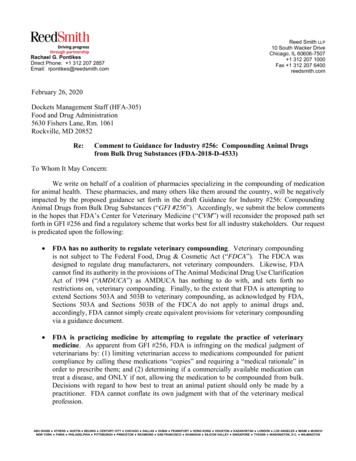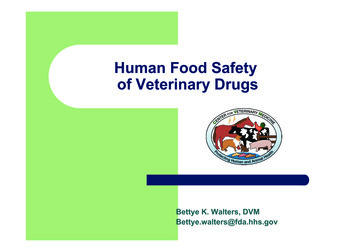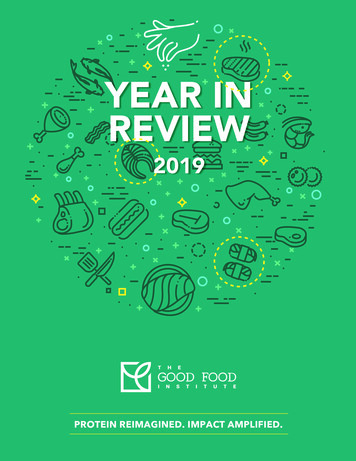
Transcription
Rachael G. PontikesDirect Phone: 1 312 207 2857Email: rpontikes@reedsmith.comReed Smith LLP10 South Wacker DriveChicago, IL 60606-7507 1 312 207 1000Fax 1 312 207 6400reedsmith.comFebruary 26, 2020Dockets Management Staff (HFA-305)Food and Drug Administration5630 Fishers Lane, Rm. 1061Rockville, MD 20852Re:Comment to Guidance for Industry #256: Compounding Animal Drugsfrom Bulk Drug Substances (FDA-2018-D-4533)To Whom It May Concern:We write on behalf of a coalition of pharmacies specializing in the compounding of medicationfor animal health. These pharmacies, and many others like them around the country, will be negativelyimpacted by the proposed guidance set forth in the draft Guidance for Industry #256: CompoundingAnimal Drugs from Bulk Drug Substances (“GFI #256”). Accordingly, we submit the below commentsin the hopes that FDA’s Center for Veterinary Medicine (“CVM”) will reconsider the proposed path setforth in GFI #256 and find a regulatory scheme that works best for all industry stakeholders. Our requestis predicated upon the following: FDA has no authority to regulate veterinary compounding. Veterinary compoundingis not subject to The Federal Food, Drug & Cosmetic Act (“FDCA”). The FDCA wasdesigned to regulate drug manufacturers, not veterinary compounders. Likewise, FDAcannot find its authority in the provisions of The Animal Medicinal Drug Use ClarificationAct of 1994 (“AMDUCA”) as AMDUCA has nothing to do with, and sets forth norestrictions on, veterinary compounding. Finally, to the extent that FDA is attempting toextend Sections 503A and 503B to veterinary compounding, as acknowledged by FDA,Sections 503A and Sections 503B of the FDCA do not apply to animal drugs and,accordingly, FDA cannot simply create equivalent provisions for veterinary compoundingvia a guidance document. FDA is practicing medicine by attempting to regulate the practice of veterinarymedicine. As apparent from GFI #256, FDA is infringing on the medical judgment ofveterinarians by: (1) limiting veterinarian access to medications compounded for patientcompliance by calling these medications “copies” and requiring a “medical rationale” inorder to prescribe them; and (2) determining if a commercially available medication cantreat a disease, and ONLY if not, allowing the medication to be compounded from bulk.Decisions with regard to how best to treat an animal patient should only be made by apractitioner. FDA cannot conflate its own judgment with that of the veterinary medicalprofession.ABU DHABI ATHENS AUSTIN BEIJING CENTURY CITY CHICAGO DALLAS DUBAI FRANKFURT HONG KONG HOUSTON KAZAKHSTAN LONDON LOS ANGELES MIAMI MUNICHNEW YORK PARIS PHILADELPHIA PITTSBURGH PRINCETON RICHMOND SAN FRANCISCO SHANGHAI SILICON VALLEY SINGAPORE TYSONS WASHINGTON, D.C. WILMINGTON
Dockets Management Staff (HFA-305)February 26, 2020Page 2 The regulatory scheme set forth in GFI #256 will have a severely negative impact onanimal health. GFI #256 must be withdrawn because (1) it supports, without justification,starting compounding with FDA-approved human and animal drugs rather than bulk activepharmaceutical ingredients, which is known to decrease quality and increase risk, andexpose animal patients to unnecessary and even dangerous ingredients; and (2) it willessentially eliminate the ability to use bulk substances to prepare compounded animalmedication for office use, and office use is a vital and necessary component in the practiceof veterinary medicine; and (3) it will increase the costs of critical compounded medicationto such an extent that animal patients will be forced to go without medical care. Veterinarycompounders employ over 40,000 formulations in their practices to treat animal patientsnationwide because FDA-approved medications are unavailable or unsuitable to meet theunique needs of animal patients on the prescriptive authority of veterinarians. The needfor such an enormous variety of formulations cannot be addressed by commerciallyavailable drugs or by the limited situation under which GFI #256 permits compoundingfrom bulk drug substances. If veterinary compounders were limited in the mannerprescribed by GFI #256, veterinarians and animal caregivers would not obtain themedication they need to care for animals, causing unnecessary suffering and, potentially,death.Accordingly, for the reasons set forth in greater detail below, we respectfully request that FDA withdrawGFI #256 and that CVM engage in further dialogue with members of this coalition, as well as otherindustry stakeholders, on the best path forward for veterinary compounding. We understand that CVMdid not meet with veterinary compounding pharmacies who provide medications for animals to discussthe implications of CVM’s policies on animal health prior to issuing the draft. To that end, we respectfullyrequest a formal meeting with CVM leadership to discuss our concerns with GFI #256 and its implicationson the treatment of animals in greater detail.1.FDA Has No Authority To Take The Positions Outlined in GFI #256.Despite the many comments submitted in response to the previous iteration of this guidance, GFI#230, FDA mistakenly continues to assert that it has authority to regulate veterinary compounding. Asset forth below, FDA does not have the authority to regulate compounded drugs for animal use.FDA in GFI #256, incorrectly, asserts that all compounded animal drugs are “new drugs” and assuch, subject to FDA control. FDA asserts that any animal drug must be either (1) approved by FDAthrough the new animal drug approval process; (2) conditionally approved pursuant to Section 571 of theFDCA; or (3) indexed under Section 572 of the FDCA. To the extent that the FDCA permits thecompounding of animal drugs without going through one of the three pathways, FDA believes it does soonly via AMDUCA and its corresponding regulation, 21 CFR 530.13. See GFI #256 at pp. 6-7. Per FDA,compounding animal drugs from bulk drug substances is animal drug manufacturing and is not permittedby the FDCA. Id. at p.6. Nevertheless, FDA recognizes that manufactured animal drugs are not alwayssuitable for treatment. As such, FDA presents us with GFI #256 as a way to permit the compounding ofanimal drugs using bulk drug substances under certain circumstances to meet treatment needs. See GFI#256 pp. 7-9.
Dockets Management Staff (HFA-305)February 26, 2020Page 3FDA’s entire premise for GFI #256 is unfounded. What FDA is essentially creating in GFI #256is a two-track federal regime to regulate veterinary compounding: (1) compounding from human or animalapproved drugs subject to the extralabel use provisions in AMDUCA and in 21 C.F.R. 530; and (2)compounding from bulk ingredients subject to the restrictions set forth in GFI #256. FDA has no authorityto create this two-track regime under the FDCA. First, veterinary compounding is not subject to theFDCA. The FDCA was designed to regulate drug manufacturers, not veterinary compounders. Likewise,FDA cannot find its authority in the provisions of AMDUCA as it has nothing to do with, and sets forthno restrictions on, veterinary compounding. Finally, with regard to GFI #256’s attempt to extend theframework set forth in Sections 503A and 503B to veterinary compounding, as acknowledged by FDA,Sections 503A and Sections 503B of the FDCA do not apply to animal drugs and, accordingly, FDAcannot simply create equivalent provisions for veterinary compounding via a guidance document. Forthese reasons, GFI #256 must, therefore, be withdrawn.(a)Veterinary Compounding Is Not Subject To The FDCA.The FDCA gives FDA the authority to regulate drug manufacturing, not veterinary compounding.Veterinary compounding has been historically regulated by the States as a traditional part of the practiceof pharmacy. There have been no amendments to the FDCA to allow FDA to regulate veterinarycompounding.As FDA is no doubt aware, veterinary compounding is expressly recognized and highly regulatedby State laws, and is a widespread practice performed by licensed pharmacy professionals andveterinarians throughout the country. Well before passage of the FDCA, over eight decades ago, Statesregulated compounding as part of their oversight of the practice of pharmacy. Since the passage of theFDCA in 1938, veterinary compounding has continued to be regulated by the States. In turn, since at least1992, FDA, Congress, and the United States Supreme Court have consistently reaffirmed that FDA doesnot have the authority to regulate traditional compounding activities, like compounding for animals, or tosubject those activities to the FDCA.Nothing has changed with respect to this State and federal balance over veterinary compoundingin the 82 years since the FDCA was enacted; and no new laws have been passed to expand FDA’s authorityover the State-regulated practice of veterinary compounding. Nevertheless, in a bid to assert authorityover yet another vestige of the nation’s healthcare regime, FDA rests its authority to regulate veterinarycompounding in FDCA’s expansive definition of “new drug. See GFI #256 at p. 3. The legislative historyof the FDCA, however, clearly supports the view that drug manufacturing, not drug compounding, wasthe intended target of the FDCA’s drug approval scheme.When it enacted the FDCA in 1938, Congress was reacting in response to a national outcry overrecent deaths involving manufactured drugs and was focused on the fact that drug manufacturing wasconducted by unlicensed, unregulated nonprofessionals. In contrast, the practice of pharmacy and,accordingly, the practice of compounding medication, was already heavily regulated by State laws.Congress’ focus on unlicensed large-scale manufacturing, and not on the licensed practice of pharmacy,demonstrates that Congress did not intend to subject all drugs compounded and dispensed by licensedprofessionals to the same regulatory scheme as drugs manufactured by unlicensed manufacturers.
Dockets Management Staff (HFA-305)February 26, 2020Page 4Congress’ desire to regulate drug manufacturing, and not compounding, is all the more obviouswhen one considers that the FDCA’s structure is an extremely poor fit for compounded animalmedications. The FDCA prohibits the introduction or delivery for introduction into interstate commerceof “new drugs” unless, among other things, an application is filed that includes “a full list of the articlesused as components of such drug,” 21 U.S.C. §§ 360b(a)(l), (b)(l)(B), as well as “full reports ofinvestigations.” Id. § 360b(b)(l)(A). FDA has long interpreted this to mean that new drugs must besubjected to extensive testing and well-controlled clinical studies to determine their safety andeffectiveness. Compounded medications by their very nature, however, often have unique componentsand are prepared to address specific, limited issues. Accordingly, compounded medications are ill-suitedfor clinical studies and, rather, are subject to separate standards designed to ensure the proper preparationof compounded medications.Given this history and context, Congress could not have intended to subject pharmacycompounded drugs to the lengthy and expensive new animal drug approval process simply by enacting abroad definition of “new drug.” Said differently, Congress did not hide the elephant of FDA regulation ofall compounded drugs in the mousehole of the FDCA’s definition of “new drug.” Courts that haveaddressed the issue also have recognized that the FDCA’s new drug approval process is an especially poorfit for regulating pharmacy compounding; and would potentially eradicate compounding despite therecognized importance, historical acceptance, and decades-long State regulation of the practice. See, e.g.,Thompson v. Western States Med Ctr., 5.35 U.S. 357, 369-70 (2002); Med. Ctr. Pharmacy v. Mukasey,536 F.3d 383, 398 (5th Cir. 2008).The well-established rule of lenity also demonstrates that GFI #256 is unlawful. The FDCAprovides for both criminal and civil penalties for any prohibited acts under 21 USC § 331. Accordingly,the rule of lenity means that FDA cannot construe the term “new drug” to criminalize more conduct thanthat which Congress intended to criminalize under the FDCA. But, that is exactly what FDA does in GFI#256 by declaring that unless an animal drug is compounded from bulk substances in accordance withGFI #256, the compounded drug will be considered unsafe and adulterated under the FDCA. In that samevein, FDA’s-construction of “new drug” is improper because FDA has never disputed that veterinarycompounding from bulk ingredients is a traditional component of pharmacy practice regulated under Statelaws and regulations. Nonetheless, via GFI #256, FDA attempts to upset the expectations of pharmaciesand veterinarians–which FDA helped to create through decades of acknowledging that veterinarycompounding is regulated primarily by the States-by unilaterally expanding its authority under the FDCA,negatively impacting the federal-State balance on traditional compounding, and potentially subjectingmany State-licensed veterinarians and pharmacists to criminal liability. This is improper.11FDA’s declaration of what is and is not illegal under the scheme set forth in GFI #256 also puts compounding pharmacies atsignificant risk. Compounding pharmacies are now apparently subject to the whole gamut of FDA enforcement powers if theydo not comply with GFI #256. This means that FDA could, according to GFI #256, seize all of a compounding pharmacy’sdrug products and active pharmaceutical ingredients simply because, for example, a veterinarian fails to make a legaldetermination that no FDA-approved, conditionally approved, or indexed drugs are available to treat an animal. GFI #256 at p.7. These and other related enforcement actions would put compounding pharmacies at the mercy of FDA based solely onFDA’s “current thinking” as established in a purportedly nonbinding guidance document. FDA does not have the authority, inthe FDCA or otherwise, to impose this type of regulatory regime.
Dockets Management Staff (HFA-305)February 26, 2020Page 5Enacting the GFI would also effectively allow FDA to preempt State pharmacy and veterinary lawsrelating to veterinary compounding. Federal preemption is only proper, however, where a statute containsan express preemption provision, there is clear evidence that Congress intended preemption of State law,or where the exercise of State authority conflicts with the exercise of federal authority under a federalstatute. Executive Order No. 13132, 64 Fed. Reg. 43, 255 (Aug. 4, 1999); Executive Memorandum onPreemption, 74 Fed. Reg. 24693, 24693–94 (May 20, 2009); see also Wyeth v. Levine, 555 U.S. 555, 565(2009) (“[I]n all pre-emption cases, and particularly in those in which Congress has legislated . . . in afield which the States have traditionally occupied . . . we start with the assumption that the historic policepowers of the States were not to be superseded by the Federal Act unless that was the clear and manifestpurpose of Congress,” (internal citations omitted)); Altria Group v. Good, 555 U.S. 70, 77 (2008) (“Whenaddressing questions of express or implied pre-emption, we begin our analysis ‘with the assumption thatthe historic police powers of the States [are] not to be superseded by the Federal Act unless that was theclear and manifest purpose of Congress.’”). Congress has not expressed through the FDCA any intent,express or implied, to preempt State veterinary compounding laws.In sum, if Congress wanted to give FDA the power to regulate all veterinary compounding, itwould have said so. It did not, and it has instead remained silent on the issue of FDA’s authorityover veterinary compounding. This silence does not give FDA the authority to declare that allveterinary compounding is per se manufacturing and subject to the FDCA. FDA cannot take overthe State-regulated practice of veterinary compounding absent statutory authority, and it cannot, inGFI #256, revise, extend, and re-interpret the FDCA. The entire purported legal basis for the GFI istherefore false.(b)FDA Is Wrong To Rely On AMDUCA As The Basis For Its Authority toRegulate Veterinary Compounding.Notwithstanding the fact that FDA has no authority whatsoever via the FDCA to regulateveterinary compounding, FDA appears to ground its alleged authority to regulate veterinary compoundingfrom bulk substances via AMDUCA. FDA is, again, wrong.AMDUCA permits veterinarians to prescribe extralabel uses of certain approved new animal drugsand approved human drugs for animals under certain conditions. Extralabel use refers to the use of anapproved drug in a manner that is not in accordance with the approved label directions. Under AMDUCAand its implementing regulations published at 21 CFR §§ 530, et seq., any extralabel use of an approvednew animal or human drug must be by or on the lawful order of a veterinarian within the context of aveterinarian-client-patient relationship (a “VCPR”). In other words, AMDUCA simply permits certainoff-label uses of FDA-approved human and animal drugs in the treatment of animals, and authorizes FDAto promulgate regulations which “establish the conditions” under which veterinarians may prescribe offlabel use of FDA-approved drug products. See 21 U.S.C. §§ 360b(a)(4) and (a)(5). AMDUCA makes noreference whatsoever to veterinary compounding generally or veterinary compounding from bulkingredients, and it does not purport to prohibit veterinary compounding from bulk ingredients or conferany authority onto FDA to regulate all veterinary compounding from bulk ingredients. If Congressintended for AMDUCA to cloak FDA with the authority to displace the States as regulators of veterinarycompounding from bulk ingredients, it would not have hidden that grant of authority in a provision relating
Dockets Management Staff (HFA-305)February 26, 2020Page 6to the off-label uses of animal drugs and without any reference of any kind to compounding. See, e.g.,Whitman v. American Trucking Assns., Inc., 531 U.S. 457, 468 (2001) (“Congress, we have held, does notalter the fundamental details of a regulatory scheme in vague terms or ancillary provisions—it does not,one might say, hide elephants in mouseholes”); FDA v. Brown & Williamson Tobacco Corp., 529 U.S.120, 160 (2000) (“[W]e are confident that Congress could not have intended to delegate a decision of sucheconomic and political significance to an agency in so cryptic a fashion”).Nevertheless, FDA has chosen to hang its hat on a threadbare assertion of authority by way ofAMDUCA. To be clear, extralabel use is not compounding. Compounding is the traditional practice ofmixing and preparing a drug compound comprised of one or more active ingredients pursuant to aprescription. “Extralabel use,” on the other hand, is defined as:Actual use or intended use of a drug in an animal in a manner that is not in accordance withthe approved labeling. This includes, but is not limited to, use in species not listed in thelabeling, use for indications (disease and other conditions) not listed in the labeling, use atdosage levels, frequencies, or routes of administration other than those stated in thelabeling, and deviation from labeled withdrawal time based on these different uses.21 CFR 530.3(a). This definition makes no reference to compounding. Nor can it, as compoundedmedication inherently has no approved label and, accordingly, cannot be “used” in a manner that isinconsistent with that label. Extralabel use and compounding have absolutely no relation to one anotherand, accordingly, FDA’s attempt to ground its authority to regulate veterinary compounding in theextralabel use provisions of AMDUCA makes no sense. See Wyeth v. Levine, 555 U.S. 555, 588 (2009)(“[A]n agency literally has no power to act, let alone pre-empt the validly enacted legislation of a sovereignState, unless and until Congress confers power upon it,” (internal citations omitted)); see also Ry. LaborExecutives’ Ass’n v. Nat’l Mediation Bd., 29 F.3d 655, 670 (D.C. Cir. 1994) (“Unable to link its assertionof authority to any statutory provision, the [Agency’s] position in this case amounts to the bare suggestionthat it possesses plenary authority to act within a given area simply because Congress has endowed it withsome authority to act in that area. We categorically reject that suggestion. Agencies owe their capacityto act to the delegation of authority, either express or implied, from the legislature.”).FDA’s regulations promulgated pursuant to AMDUCA, 21 C.F.R. § 530.13(a), also do not giveFDA the authority it seeks. Section 530.13 explicitly references both compounding and compoundingfrom bulk, even though AMDUCA made no mention of either. As previously stated, moreover, FDCAdoes not provide FDA with authority to regulate veterinary compounding. Thus, FDA is not authorizedby AMDUCA to restrict compounding from bulk via Section 530.13. Moreover, and despite FDA’sreference to bulk drugs in Section 530.13, it does not purport to regulate the practice of compounding andinstead refers parties to FDA’s non-binding guidance documents on the subject. See id.§ 530.13(c).Accordingly, neither AMDUCA nor Section 530.13 give FDA the authority it seeks to implement GFI#256.
Dockets Management Staff (HFA-305)February 26, 2020Page 7(c)FDA Does Not Have The Authority To Extend The Section 503A And 503BExemptions To Veterinary Compounding.Finally, GFI #256 is also a blatant attempt to extend Sections 503A and 503B exemptions toveterinary compounding from bulk ingredients.2 See GFI #256 at 9, imposing the prescriptionrequirements of Section 503A, and a hybrid of the Section 503A bulk ingredient requirements, ontopharmacies compounding animal drugs; GFI #256 at 11, imposing similar bulks list requirementsapplicable to Section 503B outsourcing facilities to compounded animal drugs. Guidance documentscannot be used by FDA to create new authority for itself or to impose an entirely new legislativeframework for veterinary compounding, without a statutory framework passed by Congress and signed bythe President. See Memorandum from the Attorney General, Prohibition on Improper GuidanceDocuments, Nov. 16, 2017 (“[G]uidance [documents] may not be used as a substitute for rulemaking andmay not be used to impose new requirements on entities outside the Executive Branch. Nor shouldguidance [documents] create binding standards by which the Department will determine compliance withexisting regulatory or statutory requirements.”); see also Brown & Williamson Tobacco Corp. v. Food &Drug Admin., 153 F.3d 155, 176 (4th Cir. 1998), aff’d, 529 U.S. 120 (2000) (“As the Supreme Court haspreviously stated about a different agency and its enabling statute, neither federal agencies nor the courtscan substitute their policy judgments for those of Congress.”). Guidance documents are instead to be usedto interpret, explain, or define existing regulations and existing statutory authority. There are no suchregulations or statutes with respect to FDA’s authority over veterinary compounding, and FDA cannotcreate these statutes and regulations through a purportedly nonbinding guidance document.FDA’s attempt to legislate through a guidance document is also directly contrary to the plainlanguage of The Drug Quality and Security Act (“DQSA”) and FDA’s own irrefutable and recordedpositions on the issue. The DQSA has nothing to do with veterinary compounding. It explicitly appliessolely to compounded human drugs, DQSA, p. 1 (“An Act to amend the Federal Food, Drug, and CosmeticAct [FDCA] with respect to human drug compounding”), and was enacted solely with human drugcompounding in mind. FDA has conceded this fact when it states that “Section 503A and 503B of theFD&C Act (21 U.S.C. § § 353a, 353b), which provide statutory exemptions for compounded humandrugs, do not apply to drugs compounded for use in animals.” See GFI #256 at fn. 11. FDA thereforecannot extend the DQSA to veterinary compounding by way of a guidance document.FDA has also repeatedly affirmed that the FDCA’s provisions relating to human drugcompounding do not apply to animal drugs. For example, in federal court filings, FDA explained that“[t]here is no statutory basis for extending the human drug compounding exemptions of FDAMA toanimal drugs because Congress enacted distinct exemption schemes for compounding human and animaldrugs.” United States v. Franck’s et al., Case No. 5:10-cv- 00147-TJC-TBS, Dkt. No. 54, FDA’s Mot. forSumm. J. at 16 (M.D. Fla. Dec. 13, 2010).In various guidance documents implementing the DQSA, FDA unambiguously advised theindustry that facilities only compounding animal drugs should not register as outsourcing facilities. In its2Director Eric Nelson indicated when FDA states “federal facilities (i.e., facilities operated by the Federal government),” inGFI #256, it does NOT include or implicate any animal compounding done in outsourcing facilities registered with FDA underSection 503B.
Dockets Management Staff (HFA-305)February 26, 2020Page 8final guidance for entities considering registering as an outsourcing facility under Section 503B, FDAunambiguously states that “you should not register a facility as an outsourcing facility if the only activitiesconducted at the facility are . compounding . animal drugs . because none of the products produced atthe facility would qualify for the exemptions provided in section 503B.” FDA Final Guidance, For EntitiesConsidering Whether to Register As Outsourcing Facilities Under Section 503B of the Federal Food,Drug, and Cosmetic Act, p. 4 (Aug. 2015). In its guidance concerning implementation of Section 503A,FDA unambiguously states that “Section 503A also does not apply to drugs intended for use in animals.The statutory and regulatory provisions governing the compounding of human drug products differ fromthose governing the compounding of animal drug products.” FDA Guidance, Pharmacy Compounding ofHuman Drug Products Under Section 503A of the Federal Food, Drug, and Cosmetic Act, p. 2 n. 3 (June2016). It is outrageous for FDA to now reverse course in light of these repeated and unambiguousstatements and to, without explanation and through a purportedly nonbinding GFI, transpose thelimitations of Sections 503A and 503B onto veterinary compounding.FDA also has no authority to propose a positive list for veterinary compounding akin to Section503B’s bulks positive list. See GFI #256 at Appendix. FDA does not have the power through FDCA tocreate a list of bulk ingredients that pharmacies can use for compounded animal medication. UnlikeSection 503B of the FDCA, there is nothing in the FDCA that specifically provides for a bulks list in orderfor veterinary compounders to compound medications using bulk substances for office use.Therefore, as FDA has no authority to regulate veterinary compounding in the manner set forth inGFI #256, the guidance must be immediately withdrawn.2.FDA Does Not Have The Authority To Regulate The Practice Of Veterinary Medicine ViaGFI #256.Not only does FDA lack authority to regulate veterinary compounding, also it has no authority toregulate the practice of veterinary medicine. And yet, as set forth in GFI #256, FDA replacing its ownjudgment for that of veterinarians by: (1) limiting veterinarian access to medications compounded forpatient compliance (adding flavoring) by calling these medications “copies” and requiring a “medicalrationale” in order to prescribe them; and (2) determining if a commercially available medication can treata disease, and ONLY if not, allowing the medication to be compounded from bulk. Decisions with regardto how best to treat an animal patient should only be made by a practitioner. FDA cannot conflate its ownjudgment with that of the veterinary medical profession.As a threshold matter, the practice of veterinary medicine, like the practice of pharmacy, isregulated by the States. When Congress enacted the FDCA in 1938, it intended to preserve practitioners’right to use compounded medications. Since that time, Congress has not passed any law giving FDA theauthority to propose any regulatory scheme for veterinarians’ prescribing or compounding animal drugs,let alone the comprehensive new regime set forth in GFI #256. Accordingly, the practice of veterinarymedicine is beyond the power of FDA and is instead within the purview of the States. See, e.g., Linder v.United States, 268 U.S. 5, 19 (1925); Bristol-Myers Squibb Co. v. Shalala, 91 F.3d 1493, 1496 (D.C. Cir.1996); United States v. Kaplan, 2014 U.S. Dist. LEXIS 124176, *21–22 (D. Nev. July 9, 2014). GFI #256blatantly violates this principle.
Dockets Management Staff (HFA-305)February 26, 2020Page 9GFI #256 requires veterinarians to justify, in writing, the need to compound medication using bulksubstances under certain circumstances by documenting the “medical rationale” for the compoundedmedication in the prescription or, if the veterinarian is compounding the drug, in the patient’s medicalrecord. GFI #256 at p. 10. FDA, in other words, appears intent on controlling veterinarians’ medicaljudgment by requiring them to use compounded medications only in certain, limited circumstances, andby requiring the veterinarians to justify their treatment recommendations before prescribing acompounded medication. These requirements could permit FDA to second-guess a veterinarian’s medicaljudgment and to initiate an enforcement action against the veterinarian if FDA disagrees with theveterinarian’s medical determinations as to the medical rationale for compounded medications. FDA doesnot have the authority to control State-licensed veterinarians’ medical decisions in this way.Indeed, even if FDA has the authority to regulate veterinary compounding in the manner set forthin GFI #256, FDA fails to appropriately explain how it intends to enforce that guidance. For example, aspreviously stated, GFI #2
The regulatory scheme set forth in GFI #256 will have a severely negative impact on animal health. GFI #256 must be withdrawn because (1) it supports, without justification, starting compounding with FDA-approved human and animal drugs rather than bulk active pharmaceutical ingredients, which is known to decrease quality and increase risk, and










